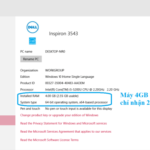If your phone is not charging, don’t worry because you can easily fix this problem with the simple instructions below from FPT Shop. Try these troubleshooting tips before taking your smartphone to the service center.
Causes of phone not charging
Not charging is a common issue for many people who have been using their mobile phones for a long time. This can cause inconvenience and difficulties in the usage. There are many reasons that can lead to phone not charging, and here are some common causes:
/fptshop.com.vn/uploads/images/tin-tuc/173368/Originals/Dien-thoai-sac-khong-vao-pin-1.jpg)
- The charging cable is worn out from long-term use.
- The charging port is clogged with dust due to lack of cleaning over time.
- The charging pins are loose or damaged.
- Your charger has lower power capacity than the original charger that comes with the phone.
- The phone accidentally gets in contact with water.
- The battery is swollen or faulty due to long-term use.
- Hardware malfunction.
- Software or operating system issues on the phone.
- The phone has multiple background apps that are not being managed properly.
- The software version is incompatible or not up-to-date.
- The power source in your house is weak or unstable.
Most effective solutions for phone not charging
Nowadays, mobile phones have become an indispensable part of our lives. However, after prolonged use, you may encounter the problem of phone not charging. Here are some troubleshooting solutions for you to consider.
Power off and restart
Turn off your phone and then restart it. This is a common and simple method to solve many issues, including charging problems. This process will help your phone temporarily resolve various issues.
/fptshop.com.vn/uploads/images/tin-tuc/173368/Originals/dien-thoai-sac-khong-vao-pin.jpg)
Enable fast charging mode
Currently, some phone brands like Samsung and Xiaomi have a fast charging feature that can be turned on or off. So, check your phone to see if you accidentally turned off this feature. If you turn off this feature, it will make your phone charge slower than usual.
Check and clean the charging port on the phone
Sometimes, during long-term use, dust or residue can accumulate in the charging port, causing the phone not to charge. In this case, you can use a small cotton swab or damp paper to clean it. Also, check if there are any cracks or oxidation inside the charging port. If you notice any issues, it is recommended to take your phone to a phone store for further inspection and repair.
Check and replace the charging pins
If you have ruled out other causes of the phone not charging, replacing the charging pins might be a feasible solution. Mobile phones have charging pins, which are components soldered onto the auxiliary circuit board and connected to the main system. If the charging pins are faulty, it can also cause slow charging. However, this process can be complex, so it is advisable to take your phone to an authorized service center for replacement.
Replace the charger or charging cable
Replacing the charger or charging cable with a new one is one of the simple and effective solutions when your phone is not charging. If your charger is damaged, the cable is broken, or the power capacity is low, you should replace them immediately. It is recommended to choose genuine chargers and cables with the appropriate power capacity to ensure stable power supply and avoid related charging issues.
Deal with water damage promptly
If you accidentally get your phone wet and didn’t have time to address it, the internal components can be damaged. This issue can cause the charging system to automatically shut off. Therefore, when facing this problem, dry your phone thoroughly and then try charging it normally.
Replace the battery
If you have been using your phone for a long time and notice battery problems, it may be the cause of the phone not charging. It is advisable to take your phone to a reputable repair center to replace the battery with a new one of good quality. Note that you should not attempt to replace the battery yourself as the process is complex and requires technical expertise.
Check the phone’s internal components
Malfunctioning or damaged internal components can also cause slow charging or no charging. Therefore, it is recommended to take your phone to a repair center for technicians to check the internal components. In case any component is found to be faulty, it should be replaced immediately to avoid further damage to the phone.
Perform a factory reset
If you find that your phone has a software issue or an operating system problem, performing a factory reset can restore the phone to its default settings. However, to avoid data loss, remember to back up your phone. After resetting the phone, check if there is still an issue with the charging.
Close unnecessary background apps
Multiple background apps running on the phone can also cause the phone not to charge. Therefore, if you find any background apps running, close them and then proceed with charging the phone.
Update to the latest software version
After ruling out hardware factors, users should check the software version they are using and compare it with the previous version to determine if the charging time has increased. If it has, users should temporarily revert to the previous version and wait for the latest version to fix any bugs and provide better stability before upgrading.
Check the power source in your house
If the power source in your house is unstable, fluctuating, or weak, it may not provide sufficient power for fast charging of your phone. In that case, you should check the overall power supply in your house by plugging in a light bulb and observing if the light flickers. If the light flickers unstably, there may be an issue with the power source, and you should seek assistance from an electrician.
Change your charging habits
If you have the habit of charging your phone through a computer, using it while charging to play games or watch movies, it can not only damage your phone but also affect the charging process.
Pay attention to safety rules when charging
To avoid the phone not charging issue, you should pay attention to the following safety rules:
- Do not charge in wet areas to prevent water from coming into contact with the charger and phone.
- Avoid placing your phone in areas with high temperature and humidity.
- Do not charge overnight as it can cause health hazards.
Download the Ampere app
Ampere is an application that allows you to check and monitor the charging process of your phone to determine the reason your phone is not charging. This app provides information such as whether your phone is charging or not, how much it has charged, the temperature during charging, remaining battery capacity, and many other factors. You can use Ampere to accurately check if the charging process is running efficiently.
In the Ampere interface, the color green indicates charging, blue indicates full charge, and orange indicates not charging.
Cleaning your phone
If your phone is not charging, use compressed air to blow away dirt in the USB charging port. After that, the connection can return to normal.
Replace with a new cable
If you suspect a faulty cable, you can easily diagnose it by using a new cable to charge your phone. If it charges successfully, it means your old cable is faulty.
Fix the USB port
First, turn off your phone, remove the battery (if possible), and use something small (like a toothpick) to gently lift the small lever inside the USB port. Note that the action should be gentle. Then, insert the battery back and plug in the charger. In 9 out of 10 cases, the phone not charging issue is caused by this.
Check the adapter
If the cable is not the issue, check the wall adapter. Sometimes, the USB charging port may loosen when plugged and unplugged multiple times.


































